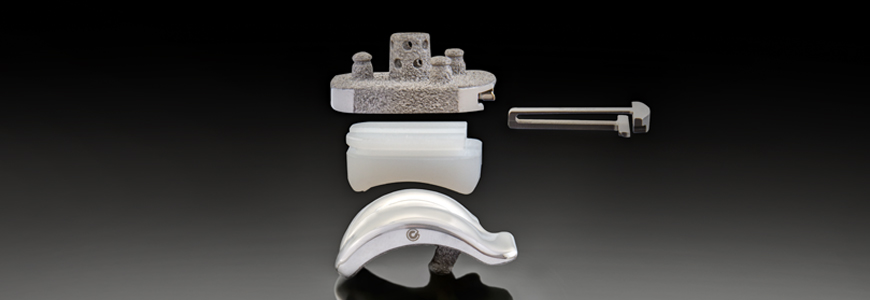For patients with end-stage ankle arthritis, nonsurgical treatment options usually do not result in lasting pain relief, and many resort to fusion surgery—at the expense of ankle motion. An innovative total ankle replacement system designed by Duke orthopaedic surgeons combines the best features of other types of replacements and offers many advantages over fusion, giving patients a new option for reducing pain and preserving flexibility and motion.
Over a five-year period, Duke foot and ankle orthopaedic surgeons Mark Easley, MD, James Nunley II, MD, and James DeOrio, MD, teamed up with a foot and ankle specialist in Switzerland, Victor Valderrabano, MD, and worked with a developer of bone and joint restoration products to design the Vantage Total Ankle System (Exactech, Inc., Gainesville, FL). The Duke team performed the world’s first arthroplasty using the system in September 2016. Now, more than 200 successful surgeries later, the advantages of the system’s design are becoming increasingly evident.
Made of metal and sturdy polyethylene, the implant has anatomically shaped talar and tibial components to preserve the natural support the body provides through the ankle’s physiologic configuration. (Figure). “The idea of our design is to ensure that weight-bearing is done directly, in a uniform manner across the surface of the implant, whether the ankle is bending forward or backward,” Easley explains.
The team modified what was already known about hip and knee replacements and applied it to the more complex ankle, then designed the implants based on the anatomy of the arthritic ankle rather than physiologically normal ankles. “For years, joint replacements have been created based on unaffected joints, but it makes good sense to develop an ankle replacement specific to the arthritic ankle,” says Easley.
Another major advantage of the Vantage system is that it was designed with minimal bone resection in mind. “We remove relatively little bone,” says Easley, “so in 10 to 15 years, should the patient develop osteolysis and the implant starts to loosen, we anticipate having adequate residual bone to perform revision ankle replacement without the need to convert to fusion. It’s our hope that this new design, with its optimal biomechanical features, will confer a lower risk for loosening and potentially remain intact and functional over the patient’s lifetime.”
Easley notes that total ankle replacement is relatively new compared with hip and knee replacement, and it has taken awhile to perfect it. “We’ve been doing ankle replacements at Duke for 20 years but have been particularly successful over the past 10 years. What’s changed is that we’ve improved the instrumentation, surgical technique, and our understanding of how the ankle works. We’re now at the point where replacement is surpassing fusion as the primary treatment option for end-stage ankle arthritis,” he says.
During patients’ annual follow-up visits, the Duke foot and ankle team follows the clinical outcomes and performs radiographic analysis. Easley emphasizes the importance of annual follow-up for total ankle patients: “Although not common, occasionally painless cysts or metal component loosening may develop. In these situations, we are typically able to intervene to patch holes and replace the non-metal polyethylene component in an effort to preserve the longevity of the total ankle replacement.”
With the vast majority of patients reporting that they have reduced pain and are markedly more functional than before surgery, it is clear that the system is effective, but one question remains: “We don’t yet know how long the total ankle replacements will last,” says Easley. “Our Duke foot and ankle team continues to study the outcomes of our total ankle replacement surgeries carefully. In general, we consider ankle replacement to have 95 percent 5-year and 90 percent 10-year survivorship rates. Those are good numbers, but with our new design and its innovations, we’re hoping to see even better results.”
Watch how the Vantage Total Ankle System works. Credit: Exactech, Inc.

